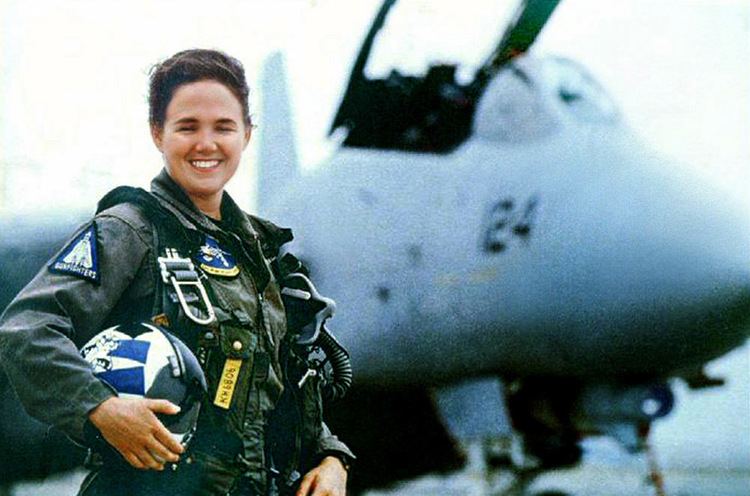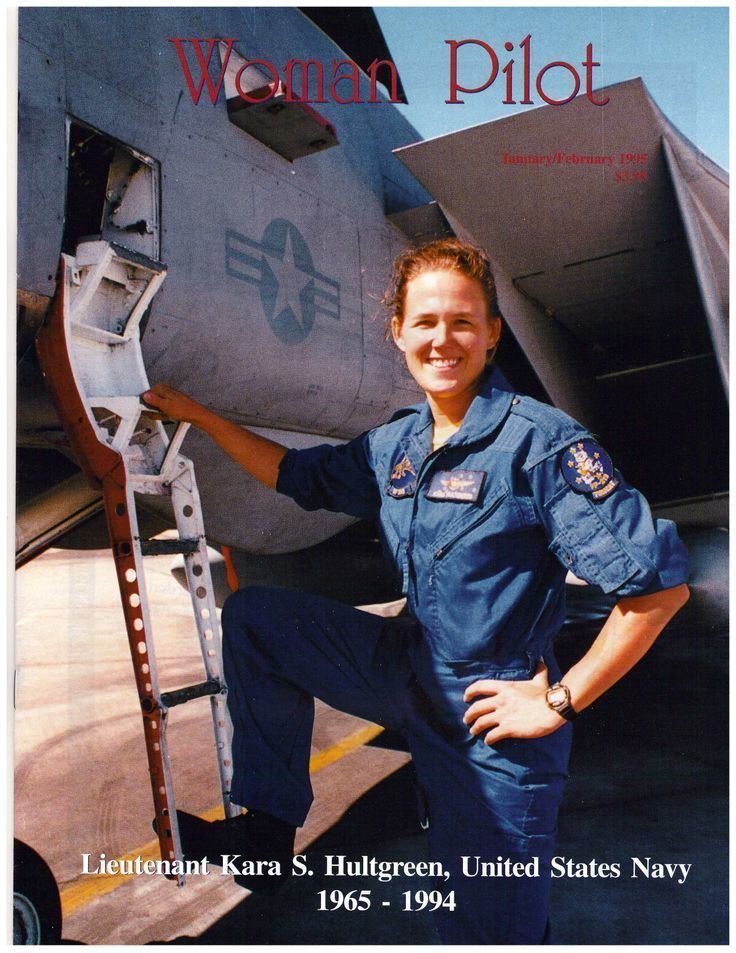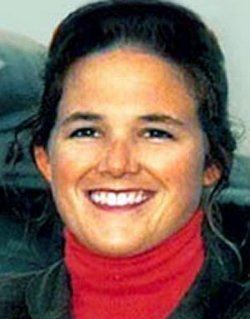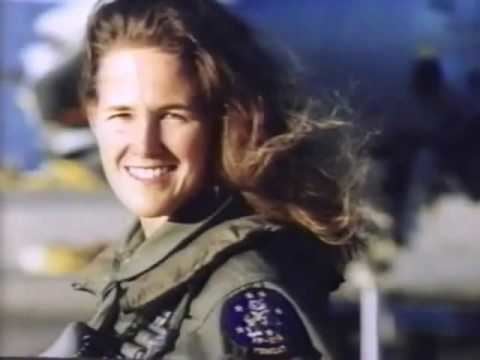Nickname(s) Revlon Name Kara Hultgreen Role Fighter pilot | Years of service 1987–94 Siblings Dagny Hultgreen Rank Lieutenant | |
 | ||
Born October 5, 1965Greenwich, Connecticut ( 1965-10-05 ) Allegiance United States of America Died October 25, 1994, San Diego, California, United States Nieces Skylar Dubelko, Paige Dubelko, Taylor Dubelko People also search for Dagny Hultgreen, Arthur W. Radford, Edward A. Craig | ||
F-14 Tomcat Tribute - Kara Hultgreen
Kara Spears Hultgreen (5 October 1965 – 25 October 1994) was a Lieutenant and Naval Aviator in the United States Navy and the first female carrier-based fighter pilot in the U.S. Navy. She died just months after she was certified for combat, when her F-14 Tomcat crashed into the sea on final approach to USS Abraham Lincoln (CVN-72).
Contents

Youth

Hultgreen was born on 5 October 1965, in Greenwich, Connecticut, and raised in both Chicago and Toronto. Hultgreen moved to San Antonio, Texas, in 1981. She attended Alamo Heights High School and received a congressional nomination to the Naval Academy but did not win an appointment. She attended the University of Texas at Austin, where she majored in Aerospace Engineering.
Military career

Hultgreen was commissioned through the Aviation Officer Candidate School at Naval Air Station Pensacola, where she was a Distinguished Naval Graduate.
Upon graduation she was assigned to Training Air Wing 4 at Naval Air Station Corpus Christi, Texas for primary flight training with VT-27 in the T-34C Turbomentor. Screened for the Strike Pilot training pipeline, she underwent follow-on training in the T-2C Buckeye and TA-4J Skyhawk II with Training Air Wing 3 at NAS Chase Field, Texas.
Following designation as a Naval Aviator, she received orders to fly EA-6A Prowlers with Tactical Electronic Warfare Squadron 33 (VAQ-33) at NAS Key West, Florida. Upon the Navy's integration of women in combat in 1993, LT Hultgreen was selected to be among the first female pilots to undergo F-14 Tomcat training at NAS Miramar, California.
While with Pacific Fleet F-14 Fleet Replacement Squadron, Fighter Squadron 124 (VF-124), Hultgreen failed her first attempt at carrier qualification. Hultgreen successfully carrier-qualified during a second period aboard USS Constellation (CV-64) in the summer of 1994, becoming the first "combat qualified" female Naval Aviator. Upon completion of the VF-124 Category I fleet replacement pilot syllabus, she was assigned to the Black Lions of Fighter Squadron 213 (VF-213) and began preparations for deployment to the Persian Gulf.
Her call signs were initially "Hulk" or "She-Hulk", for her ability to bench-press 200-pound (91 kg), her 6-foot (1.8 m) frame, and a play on her surname of Hultgreen. But after a television appearance in which she wore detectable makeup, her colleagues bestowed a new and more feminine call sign, "Revlon".
Death
On 25 October 1994, Hultgreen died when her F-14A-95-GR, BuNo 160390, coded "NH 103", crashed on approach to USS Abraham Lincoln. The incident occurred off the coast of San Diego after a routine training mission. Finding herself overshooting the landing area centerline, Hultgreen attempted to correct her approach by applying left rudder pedal, which caused the nose to disrupt the airflow over the left (inside) wing, as well as the airflow to the left engine intake. (The approach turn stall, aerodynamic effect and the appropriate recovery technique were taught throughout the period that Hultgreen completed primary (undergraduate) flight training.) The left-hand engine suffered a compressor stall and lost power—a well-known deficiency characteristic of the F-14A's TF30-P-414A engine when inlet air was no longer flowing straight into it. The F-14 NATOPS flight manual warned against excess yaw for this reason. Loss of an F-14 engine results in asymmetric thrust, which can exceed rudder authority, especially at low speeds.
After aborting the approach, Hultgreen selected full afterburner on the remaining engine, causing an even greater asymmetry. This, combined with a high angle of attack, caused an unrecoverable approach turn stall and rapid wing drop to the left. The radar intercept officer (RIO) in the rear seat, Lieutenant Matthew Klemish, initiated ejection for himself and Hultgreen as soon as it was apparent that the aircraft was becoming uncontrollable. First in the automated ejection sequence, the RIO survived. However, by the time Hultgreen's seat fired 0.4 seconds later, the plane had exceeded 90 degrees of roll, and she was ejected downward into the water. She was killed instantly. The entire event unfolded in less than 20 seconds.
On 12 November, 19 days after the crash, the Navy salvaged the plane and recovered her body, still strapped into the ejection seat. The wreckage was in 3,700 feet (1,100 m) of water. On 21 November, she was buried in Arlington National Cemetery, with full military honors.
The F-14A lost in the mishap, BuNo 160390, had been one of the two involved in the Gulf of Sidra incident of 1981, when it was previously assigned to Fighter Squadron 41 (VF-41) at NAS Oceana, Virginia, and embarked with Carrier Air Wing Eight (CVW-8) aboard USS Nimitz.
As with most approaches to a carrier landing, Hultgreen's incident was videotaped by two cameras. The tape shows an overshooting turn onto final, then apparent engine failure, followed by an audible wave-off and gear-up command from the landing signal officer. Segments shown on broadcast television concluded with the rapid sequence of aircraft stall, roll, crew ejections, and impact with the water.
Controversy
Elaine Donnelly of the Center for Military Readiness (CMR) suggests that Hultgreen "may have been the victim of a flawed policy", which overlooked her mistakes in training, two of which were similar to those that caused her death. The other pilot named by the center subsequently brought a suit for defamation against the CMR, but lost because the court determined that, by virtue of her status as one of the first women to attempt to qualify as a carrier combat pilot, she was a "public figure" and had to prove malice on the part of those who published the charge of favoritism.
An Accuracy in Media reports others quoting CDR Tom Sobiek, commanding officer of Fighter Squadron VF-124, as saying of the four female pilots in his squadron, "the women are going to graduate regardless of how they performed" and that "the Navy was in a race with the Air Force to get the first female fighter pilot". It quotes Sobiek denying making any such statement. "That is a flat **** lie," he said. "And whoever told you that, if they were under oath, should be taken to task."
